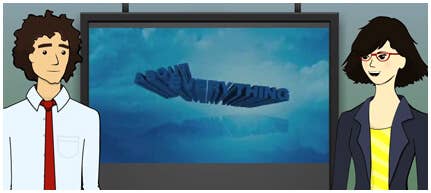Virtual News Cast – Are Any Journalists Safe From Automation? (videos)

Share

They took our jobs! ...or, you know, they could one day.
If you're majoring in journalism, you may want to switch to computer science. Virtual newscasts, though primitive, are making major inroads into the field. Northwestern University has a virtual video news program called News at Seven. Using phrases, images, and clips taken from the internet, News at Seven can create a general news anchor segment, movie reviews, celebrity shout outs, or a pop culture opinion segment (called Angry Fish). Appearing regularly at Zap2it, the virtual hosts aren't much to listen to, and they're not ready for prime time, but they are getting better. Check out examples of each news segment in the videos after the break.
Northwestern already has the writing world in debate over its virtual sports journalist program, Stats Monkey. With News at Seven, the university is taking automated information dispensing to the next level. The news segments cover a wide range of interests, from hard science to celebrity gossip. While the current virtual hosts are annoying, when it comes to entertainment industry news I can't say I prefer the real ones over the fakes. Eventually, the simulated personalities could be improved, and their voices made more realistic. Or, taking a page from Hanson robotics, lovable animatronic androids could speak the words that the News at Seven program writes. Either way, we could eventually see VR news as a reasonable alternative to the seemingly formulaic programs produced by many studios.
News at Seven Movie Review:
News at Seven Celebrity Shout Out (More can be found here at Zap2it):
The Angry Fish
Be Part of the Future
Sign up to receive top stories about groundbreaking technologies and visionary thinkers from SingularityHub.


A review of News at Seven by Science Nation (NSF)
As you can see in these videos, both the script and the performance of these news segments leaves much to be desired. In clear contrast to Stats Monkey, which writes amazingly well compared to human sports journalists, News at Seven is clearly computer created.
Or rather it's computer compiled. Everything you hear in these segments, barring transitional phrases and hand offs between hosts, is actually a repetition of words taken from online sources. Which is a major limitation. First, because this means that such a virtual could never actually replace all journalists, but more importantly because it doesn't seem to filter the comments for any sense of credibility. Oh, the script makes sense, and the opinions presented from different hosts seem to argue different points, but many comments are purely inane. That's the internet for you.
Still, I am impressed that the Northwestern computer program can make sense out of internet opinions at all, and the included of pictures and video seem to be relevant and appropriate. In other words, while I don't think that the current version News at Seven could replace even a low budget high school news team, there are signs that it could certainly help augment one. Eventually, with a better way of selecting online information and improved performances from its hosts, News at Seven could help small communities develop local news segments. One day, when VR and AI have advanced sufficiently, we could even see virtual news tackle some of the major media outlets. "...This is CNN, the Cyborg News Network."
[photo credit: Northwestern University]
Related Articles

These Brain Implants Are Smaller Than Cells and Can Be Injected Into Veins

This Wireless Brain Implant Is Smaller Than a Grain of Salt

Record-Breaking Qubits Are Stable for 15 Times Longer Than Google and IBM’s Designs
What we’re reading